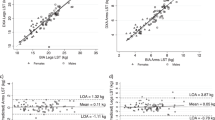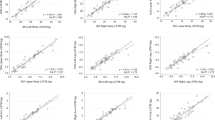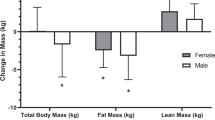Abstract
Background
The objective for percent body fat standards in the United States Army Body Composition Program (ABCP) is to ensure soldiers maintain optimal well-being and performance under all conditions. However, conducting large-scale experiments within the United States Army to evaluate the efficacy of the thresholds is challenging.
Methods
A receiver operating characteristic (ROC) analysis with corresponding area under the curve (AUC) was performed on body mass index (BMI) and waist circumference to determine optimal gender-specific age cohort thresholds that meet ABCP percent body fat standards in the National Health and Nutrition Examination Survey (NHANES) III. A second dataset consisting of a cohort of basic training recruits (N = 20,896 soldiers, 28% female) with BMI and waist circumference measured using a 3D body image scanner was applied to calculate what percent of basic training recruits meet the ABCP percent body fat standards. Regression models to determine the contribution of different circumference sites to the predictions of percent body fat were developed using a database compiled at the New York Obesity Research Center (N = 500).
Results
Optimal BMI thresholds ranged from 23.65 kg/m2 (17–21-year-old cohort) to 26.55 kg/m2 (40 and over age cohort) for males and 21.75 to 24.85 kg/m2 for females. The AUC values were between 0.86 and 0.92. The waist circumference thresholds ranged 81.35 to 97.55 cm for males and 77.05 to 89.35 cm for females with AUC values between 0.90 and 0.91. These BMI thresholds were exceeded by 65% of male and 74% of female basic training recruits and waist circumference thresholds were exceeded by 73% of male and 85% of female recruits. The single circumference that contributed most to prediction of body fat was waist circumference in males and mid-thigh circumference in females.
Conclusions
The ABCP percent body fat thresholds yield BMI thresholds that are below the United States Army BMI standards, especially in females which suggests the ABCP percent body fat standards may be too restrictive. The United States Army percent body fat standards could instead be matched to existing national health guidelines.
This is a preview of subscription content, access via your institution
Access options
Subscribe to this journal
Receive 12 print issues and online access
$259.00 per year
only $21.58 per issue
Buy this article
- Purchase on Springer Link
- Instant access to full article PDF
Prices may be subject to local taxes which are calculated during checkout


Similar content being viewed by others
References
Hertling M. Unfit to serve obesity is Impacting National Security. 2017. https://www.cdc.gov/physicalactivity/downloads/unfit-to-serve.pdf. Accessed 14 March 2018.
DoD, editor. Army Regulation 600-9: The Army Body Composition Program. Washington DC: The Department of the Army; 2013.
Marriott BM, Grumstrup-Scott J, editors. Body composition and physical performance: applications for the military services. Washington (DC): U.S. Department of Health and Human Services; 1990.
Friedl KE. Body compos Mil perform—many things many. People J Strength Cond Res. 2012;26(Suppl 2):S87–100. https://doi.org/10.1519/JSC.0b013e31825ced6c.
DoD, editor. Army regulation 670-1: wear and appearance of army uniforms and insignia. Washington D.C.: The Department of the Army; 2014.
Knechtle B, Knechtle P, Rosemann T, Lepers R. Predictor variables for a 100-km race time in male ultra-marathoners. Percept Mot Skills. 2010;111:681–93. https://doi.org/10.2466/05.25.PMS.111.6.681-693.
Barandun U, Knechtle B, Knechtle P, Klipstein A, Rust CA, Rosemann T, et al. Running speed during training and percent body fat predict race time in recreational male marathoners. Open Access J Sports Med. 2012;3:51–8. https://doi.org/10.2147/OAJSM.S33284.
Collins SM, Silberlicht M, Perzinski C, Smith SP, Davidson PW. The relationship between body composition and preseason performance tests of collegiate male lacrosse players. J Strength Cond Res. 2014;28:2673–9. https://doi.org/10.1519/JSC.0000000000000454.
Knechtle B, Wirth A, Baumann B, Knechtle P, Rosemann T, Oliver S. Differential correlations between anthropometry, training volume, and performance in male and female Ironman triathletes. J Strength Cond Res. 2010;24:2785–93. https://doi.org/10.1519/JSC.0b013e3181c643b6.
Zinn C, Wood M, Williden M, Chatterton S, Maunder E. Ketogenic diet benefits body composition and well-being but not performance in a pilot case study of New Zealand endurance athletes. J Int Soc Sports Nutr. 2017;14:22 https://doi.org/10.1186/s12970-017-0180-0.
Tanda G, Knechtle B. Marathon performance in relation to body fat percentage and training indices in recreational male runners. Open Access J Sports Med. 2013;4:141–9. https://doi.org/10.2147/OAJSM.S44945.
Crawford K, Fleishman K, Abt JP, Sell TC, Lovalekar M, Nagai T, et al. Less body fat improves physical and physiological performance in army soldiers. Mil Med. 2011;176:35–43.
Steed CL, Krull BR, Morgan AL, Tucker RM, Ludy MJ. Relationship between body fat and physical fitness in army ROTC cadets. Mil Med. 2016;181:1007–12. https://doi.org/10.7205/MILMED-D-15-00425.
Vogel JA. Obesity and its relation to physical fitness in the U.S. Military. Armed Forces Soc. 1992;18:497.
Baracos V, Caserotti P, Earthman CP, Fields D, Gallagher D, Hall KD, et al. Advances in the science and application of body composition measurement. JPEN J Parenter Enter Nutr. 2012;36:96–107. https://doi.org/10.1177/0148607111417448.
Friedl KE. Can you be large and not obese? The distinction between body weight, body fat, and abdominal fat in occupational standards. Diabetes Technol Ther. 2004;6:732–49. https://doi.org/10.1089/dia.2004.6.732.
Friedl KE, Leu JR. Body fat standards and individual physical readiness in a randomized Army sample: screening weights, methods of fat assessment, and linkage to physical fitness. Mil Med. 2002;167:994–1000.
Nordhamn K, Sodergren E, Olsson E, Karlstrom B, Vessby B, Berglund L. Reliability of anthropometric measurements in overweight and lean subjects: consequences for correlations between anthropometric and other variables. Int J Obes Relat Metab Disord. 2000;24:652–7.
Wang J, Bartsch G, Rahgavan SS, Yurik T, Peng G, Chen L, et al. Reliability of body circumference and skinfold measurements by observers trained in groups. Int J Body Comp Res. 2004;2:31–6.
Bosy-Westphal A, Booke CA, Blocker T, Kossel E, Goele K, Later W, et al. Measurement site for waist circumference affects its accuracy as an index of visceral and abdominal subcutaneous fat in a Caucasian population. J Nutr. 2010;140:954–61.
Sun Q, van Dam RM, Spiegelman D, Heymsfield SB, Willett WC, Hu FB. Comparison of dual-energy x-ray absorptiometric and anthropometric measures of adiposity in relation to adiposity-related biologic factors. Am J Epidemiol. 2010;172:1442–54.
US Army Training Center, Fort Jackson. http://jackson.armylive.dodlive.mil/about/. Accessed 7-11-2018
Kuehnapfel A, Ahnert P, Loeffler M, Broda A, Scholz M. Reliability of 3D laser-based anthropometry and comparison with classical anthropometry. Sci Rep. 2016;6:26672. https://doi.org/10.1038/srep26672.
Soileau L, Bautista D, Johnson C, Gao C, Zhang K, Li X, et al. Automated anthropometric phenotyping with novel Kinect-based three-dimensional imaging method: comparison with a reference laser imaging system. Eur J Clin Nutr. 2016;70:475–81. https://doi.org/10.1038/ejcn.2015.132.
Thomas DM, Bredlau C, Bosy-Westphal A, Mueller M, Shen W, Gallagher D, et al. Relationships between body roundness with body fat and visceral adipose tissue emerging from a new geometrical model. Obesity. 2013;21:2264–71. https://doi.org/10.1002/oby.20408.
Freedman DS, Thornton JC, Pi-Sunyer FX, Heymsfield SB, Wang J, Pierson RN Jr., et al. The body adiposity index (hip circumference / height(1.5)) is not a more accurate measure of adiposity than is BMI, waist circumference, or hip circumference. Obesity. 2012;20:2438–44. https://doi.org/10.1038/oby.2012.81.
Heymsfield SB, Martin-Nguyen A, Fong TM, Gallagher D, Pietrobelli A. Body circumferences: clinical implications emerging from a new geometric model. Nutr Metab. 2008;5:24. https://doi.org/10.1186/1743-7075-5-24.
CDC. The National Health and Nutrition Examination Survey (NHANES) anthropometry procedures manual. Atlanta, GA: CDC; 2007.
World Health Organization. Expert report, waist circumference and waist-to-hip ratio. WHO Document Production Services, Geneva; 2008.
R Core Team (2013). R: A language and environment for statistical computing. R Foundation for Statistical Computing, Vienna, Austria.
Friedl KE. Biomedical research on health and performance of military women: accomplishments of the Defense Women’s Health Research Program (DWHRP). J Women’s Health. 2005;14:764–802. https://doi.org/10.1089/jwh.2005.14.764.
Acknowledgements
We would like to thank Robert Bona from Human Solutions, LTC Jason Pieri, MAJ Brian Kriesel, and the Fort Jackson team for their support and assistance in compiling the data. We also appreciate the feedback given by an anonymous reviewer, which greatly improved the manuscript.
Author information
Authors and Affiliations
Corresponding author
Ethics declarations
Conflict of interest
The authors declare that they have no conflict of interest.
Electronic supplementary material
Rights and permissions
About this article
Cite this article
Nelson, R., Cheatham, J., Gallagher, D. et al. Revisiting the United States Army body composition standards: a receiver operating characteristic analysis. Int J Obes 43, 1508–1515 (2019). https://doi.org/10.1038/s41366-018-0195-x
Received:
Revised:
Accepted:
Published:
Issue Date:
DOI: https://doi.org/10.1038/s41366-018-0195-x
This article is cited by
-
Mobile phone applications for 3-dimensional scanning and digital anthropometry: a precision comparison with traditional scanners
European Journal of Clinical Nutrition (2024)



